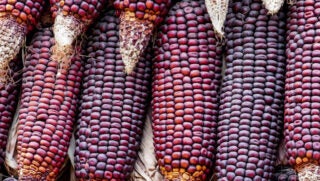Following Thursday evening’s world premier of “Farmers For America” in correlation with the National FFA Convention in Indianapolis, we had the opportunity to hear from two of the couples featured in the film. And both operations have clearly found their own niche in farming.
Matthew Keener always wondered how he could make a living off the farm his family had owned for 200 years near Dayton, Ohio. When his grandfather got out of the business and went to work for General Motors, all of the family farmland was rented out for row crops.
After spending time on a big cow/calf operation in Montana, Matthew decided to return home and seize an opportunity in the local food movement. And it has paid off for Matthew and his partner Amber Epsey. The couple has now converted all 160 acres to pasture, picked up a couple lease farms, and are hoping to raise 750 to 1,000 cattle on the land in the next four to five years.
How do they do it? They sell their high-end product to local restaurants and even colleges. And now Amber has even opened up a local deli and butcher shop.
“We don’t have all the money and the big equipment, so for me cattle is only the way to go and I can raise grass and put pounds on cows,” Matthew said.
Read our review of “Farmers For America” by clicking here.
Nate and Liz Brownlee own Nightfall Farm in Crothersville, Indiana, where they raise all their livestock on pasture and sell the meat locally within their community. Nate didn’t grow up with a farming background and in fact was a vegetarian for four-and-a-half years before he realized that participating from birth to death in animal production is a great way to be part of the food production system. He and his wife Liz spent about six years working for other farms up in New England before they decided to come home to Indiana and start building something for themselves.
“I took a couple classes in college and it really opened my eyes that the farm really reflects the farmer,” Nate said. “There is no one single definition of what a farm is and it can mean a lot of different things to a lot of different people.”
Liz, who did grow up on a farm and was active in 4-H and FFA, was trying her hand at environmental science when an Amish farmer in Pennsylvania convinced her to farm full time, telling the Brownlees: “Don’t let anyone tell you you can’t make a living at farming. If you want to do it, do it.”
But starting and maintaining their operations hasn’t been easy.
For Keener Farms, capital has been the major issue — the transition period, the fencing, the pasture seeding has all been really expensive.
“And once you get it in place, if you don’t have an active customer base that is willing to pay you a higher price point, rather than taking it to producer or the sale barn, it doesn’t any sense to take that land and put it into pasture,” Matthew said.
The upside for Keener Farms has been a strong urban environment. Within a 150 mile radius of their farm, there is 14.9 million people.
After attending a marketing seminar with Joel Salatin, Matthew said he really took heed of his advice: “You don’t need to see the goal, you just need to see the direction you want to go and take a couple steps.”
“I still don’t see the goal, but I know we are going in the right direction and I keep going,” Matthew said.
For the Brownlees, educating consumers about the meat they produce and finding support from other young farmers doing similar things has been issues for them. Acceptance from their neighbors has been difficult at times.
“Some people think I’m crazy, but the truth is this is what our communities need,” Liz said.
Liz said it is also something she needs. She loves being outside and she doesn’t want to work in an office. For Nate, it’s not all joy and not always easy to get up in the morning, but it’s the customer appreciation that makes him feel like a “rock star.” It’s also something he has to be.
“Somebody once told me that ‘you have to have to be a farmer if you want to be a farmer,'” Nate said.
For Matthew and Amber, it has been a joy to take the family farmland from rented out corn and soybeans to the financial stability they have created with their cattle operation.
“We don’t have the huge iron and the big acres, but we have the captive audience that is willing to pay you a few extra bucks for what you are producing,” Matthew said.
The community support has also been overwhelming for Keener Farms.
“My biggest joy everyday is getting to see the new faces and old faces that come in the butcher shop and meeting people that support us,” Amber said.



